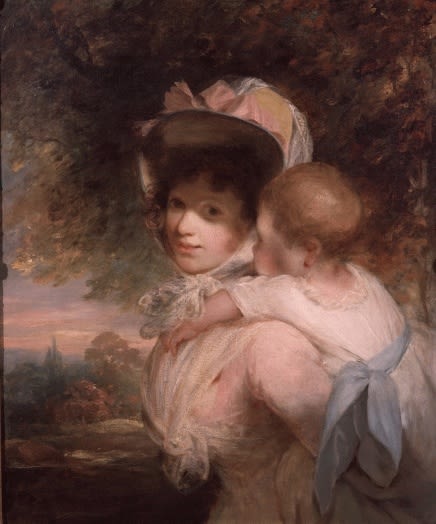
John Hoppner RA
A Mother and Child, c. 1790
Oil on canvas
30 x 25 in. (76.2 x 63.5 cm)
Philip Mould & Co.
To view all current artworks for sale visit philipmould.com Along with Gainsborough and Renolds, Hoppner was one of the leading portrait painters in late eighteenth-century Britain. Born in London...
To view all current artworks for sale visit philipmould.com
Along with Gainsborough and Renolds, Hoppner was one of the leading portrait painters in late eighteenth-century Britain. Born in London on 25 April 1758, he entered the Royal Academy Schools in 1775, where he won a Gold Medal in 1782. He was a regular contributor to the Royal Academy exhibitions and quickly established himself as a fashionable portrait painter. He was appointed painter to the Prince of Wales in 1789.
At first his work was inspired by the later portraits of Reynolds, but he soon developed an individual style that is distinguished by bravura and vivacity, combined with a strong feeling of character. From the 1790s he was also the only serious rival to the young Lawrence and with him was responsible for painting the finest Romantic portraits of the Regency period. These works (of which A Mother and Child is a fine example), show a deliberate move away from the classicism of Reynolds, towards a more emotional and natural-looking image.
In a letter dated August 1935, the art historian W. Roberts suggests that the lady in the present work may be the artist's wife, Phoebe Wright, whom he married in 1781.
Along with Gainsborough and Renolds, Hoppner was one of the leading portrait painters in late eighteenth-century Britain. Born in London on 25 April 1758, he entered the Royal Academy Schools in 1775, where he won a Gold Medal in 1782. He was a regular contributor to the Royal Academy exhibitions and quickly established himself as a fashionable portrait painter. He was appointed painter to the Prince of Wales in 1789.
At first his work was inspired by the later portraits of Reynolds, but he soon developed an individual style that is distinguished by bravura and vivacity, combined with a strong feeling of character. From the 1790s he was also the only serious rival to the young Lawrence and with him was responsible for painting the finest Romantic portraits of the Regency period. These works (of which A Mother and Child is a fine example), show a deliberate move away from the classicism of Reynolds, towards a more emotional and natural-looking image.
In a letter dated August 1935, the art historian W. Roberts suggests that the lady in the present work may be the artist's wife, Phoebe Wright, whom he married in 1781.
Provenance
Possibly Anthony Bathe and by descent to Ellis M.Watson, HertfordshireWith J. Leger, London, 1930
Collection of Smedley Aston Esq.
Collection of Helen Iversen Dixon, U.S.A.